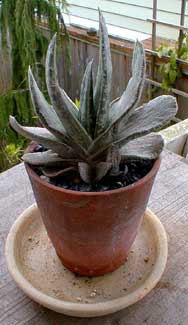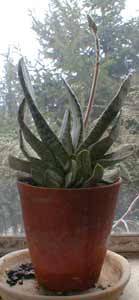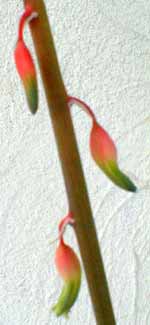
Variegated Gasteria
"The Opening & the Close
Of Being, are alike
Or differ, if they do,
As Bloom upon a Stalk."
-Emily Dickinson
(1830‚1886)
(1830‚1886)
Gasteria nigricans marmorata, synonymous with G. branchyphylla brachyphylla, is native of the western cape of South Africa. It is a succulent related to aloes, formerly placed in the same genus.
In our area, it is a basic hardy house plant, but cannot be put outside. It does not like to experience temperatures below 30 degrees Fahrenheit. It could live outdoors very happily in zones ten or eleven.
 Gasterias do not always bloom reliably, so are grown largely for the thick succulent leaves. The older a specimen becomes, the more apt it is to flower, & conceivably it helps to permit the plant to become root-bound to increase odds of flowering.
Gasterias do not always bloom reliably, so are grown largely for the thick succulent leaves. The older a specimen becomes, the more apt it is to flower, & conceivably it helps to permit the plant to become root-bound to increase odds of flowering.Because of the shape of the leaves, the whole genus is bestowed with such common names as "Ox-tongue Cactus" or "Cow's-tongue Plant" or even sometimes "Lawyer's-tongue." In some gasterias the leaves are arranged into circular rosettes, but for C. nigricans they are "distichous" leaves, arranged in opposing pairs with new opposing pairs erupting from the center until they form a fat-leafed little fan.
Gasterias are sometimes called "Stomach Plants" & genus name means "Stomach" because of the flowers. On some species of Gasteria including G. nigricans, the pendulous blossoms look like very fat sacks, gourds, or stomachs.
 The flower spike first shoots up to a foot height with a pointy head full of little green buds. The spike continues to grow to two feet, spacing out individual buds so that each bud finishes blooming apart from the others. The individual wee flowers open into a shape a bit like nasube Japanese eggplant, then continues to fatten up at the bottom until it looks like a stomach, & when fully opened the dangled end folds open to permit ingress of pollinators.
The flower spike first shoots up to a foot height with a pointy head full of little green buds. The spike continues to grow to two feet, spacing out individual buds so that each bud finishes blooming apart from the others. The individual wee flowers open into a shape a bit like nasube Japanese eggplant, then continues to fatten up at the bottom until it looks like a stomach, & when fully opened the dangled end folds open to permit ingress of pollinators.The flowers dangle in tricolors of dusty-pink at the swollen base, fading to cream in the center of the "neck" & green at the open tubular mouth. Ours is shown in the second photo in early January (2004) with green buds on a single long stem lifted well above the leaves. The third photo shows the blossoms in late January. The following year these blooms occured a mite later, in February. In Africa it would bloom much later in the year (at summer's end), but ours doesn't recognize seasons.
Flowers of the genus are edible & have a bean-flavor but with a burning sensation. Budding flowers of G. brachyphylla are cooked with rice, & G. nigricans in stews. The native name for G. nigricans is "Oukossie," referring to its edibility.
Some tribal peoples ascribe magical properties to various species of gasteria. Consuming a variety of gasteria that camouflages itself extremely well confers a degree of invisibility to a hunter or warrior. Gasteria is sometimes planted on thatched roofs because of a belief in its ability to repel lightning, just as Sempervivum hen & chicks were planted on roofs in northern Europe to repel lightning.
The genus contains more than a dozen species which hybridize easily, so that the identity of many of the houseplant offerings is often in question, but ours was offered specifically as G. nigricans var. marmorata, or Variegated Gasteria. It has ivory striped or mottled leaves; older specimens may add a chocolaty blush to some of the leaves.
Our little plant had been sitting in a south-exposed window for two years when the first photo was taken (April 2003). Gasterias can thrive even with low-light conditions since in nature they typically grow in the shade of large herbs, but ours is in full morning window-sun & has not shown any signs of overheating or over-sunning.
In hotter zones than the cool Northwest, strong direct sun would exhaust the plant. Ideally it would be given a location of bright shade. It makes a great arid terrarium plant, tough enough for a lizard or snake to crawl over it without injury to the plant.
It has not grown much in height since we got it, but added two new "bow tie" leaf-sets on the sun-facing side of its rootcrown; these offset youngsters could be separated for new plants, though I intend to let the plant grow thicker with offsets over time. New plants can be propagated by separating even one of its fat leaves to start separately, as well as by dividing any profusely leafed clump.
They can also be grown from seed, but getting them to produce seeds requires cross-pollination, which in nature is performed by birds, & in cultivation done by carefully intruding a matchstick into each flower by turns. Because various gasterias were brought to Europe three hundred years ago, they have long been cultivated, & they are so often hybridized that really pure species-plants are not usually encountered.
They are shallow rooted & can do with regular fertilizing in organically enriched sandy soil that drains well, sparingly watered year-round, permitted to dry out completely between waterings. Terra cotta or clay pots are best, careful not to plant them in anything that holds moisture too well. Because of its slow growth it will probably not need repotting for three or four years, at which time it can either be divided into multiple plants or given the next pot size up to keep growing wider.